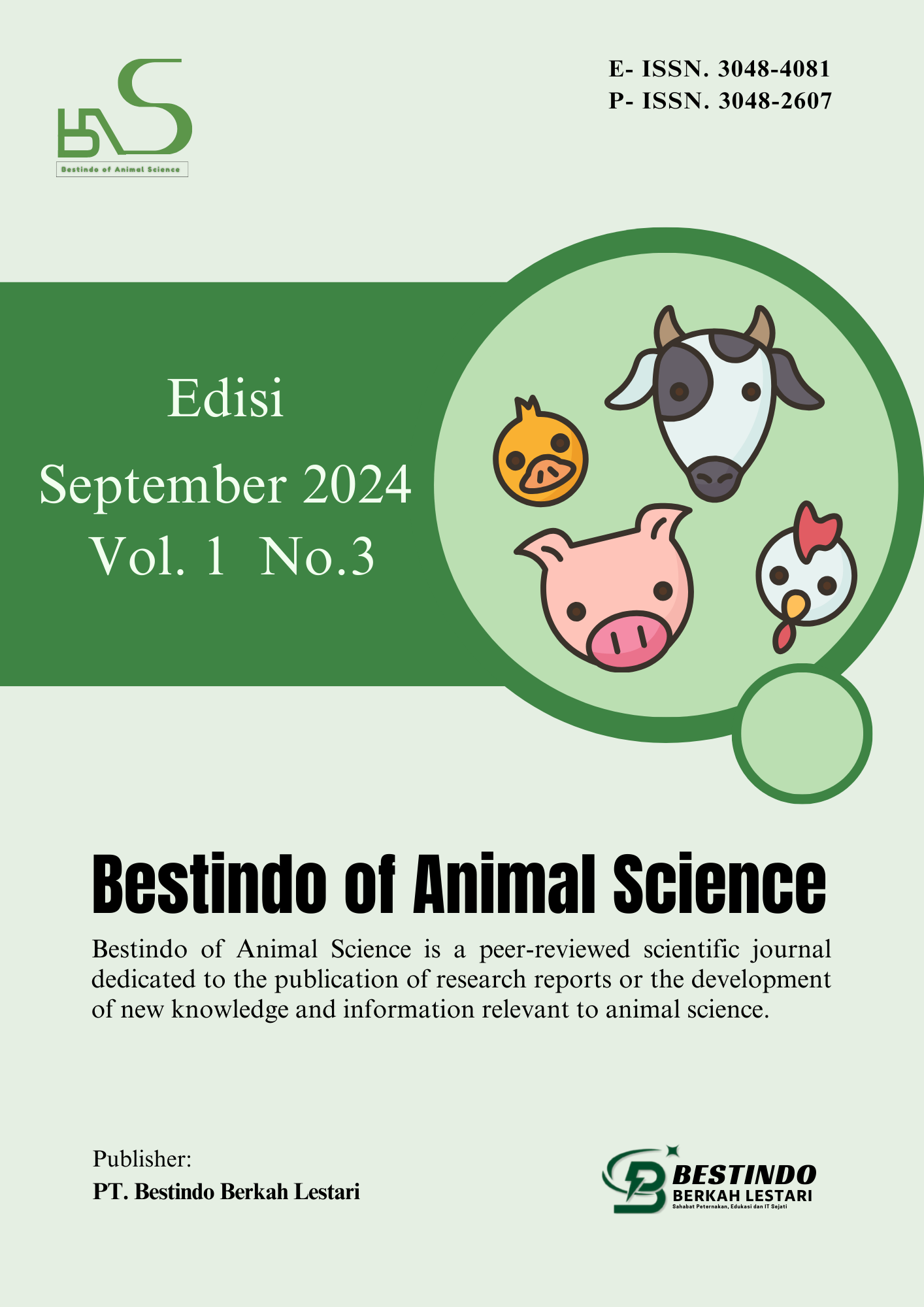Study of Handling of Animal Market Waste in Probolinggo City
Keywords:
Animal market, drainase, green house gas, handling, wasteAbstract
This study aims to determine the handling of animal market waste. This study is a field study conducted using quantitative descriptive methods using surveys, observations, descriptive and analytical. The description is carried out from the results of statistical analysis of the data collected during the study. The results of this study showed that in the animal market of Probolinggo city there is already a drainage system but it has not been integrated completely in the animal market area, there is a parking lot for cattle transport vehicles in the east which is integrated with the area where cattle are traded, and there are facilities such as public toilets, prayer rooms, buying and selling areas, canteens, etc. The animal market operates every week on Tuesdays and Saturdays at 15.00-20.00 WIB. The average number of cattle for buying and selling activities is around 800-950 cows, where from this number of cows it produces livestock waste of approximately 924.07 kg/day. Handling of animal waste in the market area is still not effective because the integrated waste disposal site is not operating properly. In addition, livestock waste is not immediately cleaned after trading activities are completed but is cleaned the next day. The conclusion of this study is that the handling of animal market waste in Probolinggo village is not optimal, which is reflected in the absence of integrated drainage arrangements throughout the market area.
References
Akbar, M. A. R., & Haryuni, N. (2024). Strategi pembuatan dan implementasi recording di industri peternakan. PT. Bestindo Berkah Lestari.
Alam, Y., Harliana, H., Haryuni, N., & Oktaviani, R. T. (2024). Pengelolaan Limbah Rumah Tangga Berbasis Komunitas untuk Produksi Pupuk Kompos Organik. Welfare : Jurnal Pengabdian Masyarakat, 2(4), 748–753. https://doi.org/10.30762/welfare.v2i4.1964
Alfami, M. A., & Haryuni, N. (2024). Identification of Beef Farming in Dayu Village. Bestindo of Animal Science, 1(1), 27–34. Retrieved from https://bestindolestari.id/index.php/bas/article/view/9
Budiyanto, Krisno. (2011). Tipologi Pendayagunaan Kotoran Sapi dalam Upaya Mendukung Pertanian Organik di Desa Sumbersari Kecamatan Poncokusumo Kabupaten Malang. Jurnal GAMMA 7. Malang.
EDI, D. N., & HARYUNI, N. (2023). Estimation of Greenhouse Gas Emission Burden of Livestock Sector in East Java Province, Indonesia: Estimasi Beban Emisi Gas Rumah Kaca dari Sektor Peternakan di Provinsi Jawa Timur, Indonesia. Jurnal Teknologi Lingkungan, 24(2), 157-165.
Ginting. (2007). Penuntun Praktikum Teknologi Pengolahan Limbah Peternakan. Universitas Sumatera Utara Repository. Medan.
Haryuni, N. (2018). Methane Mitigation Technology In Ruminants To Reduce The Negative Impacts Of Global Warming. Journal Of Development Research, 2(2), 55-58.
Haryuni, N., & Muanam, M. K. (2023). Potret BUMDES Sido Makmur Sejahtera. PT. Bestindo Berkah Lestari.
Haryuni, N., Harliana, H., Khoirul Muanam, M. ., Alam, Y. ., & Izzudin, A. . (2024). Pelatihan Pembuatan Pakan Sapi untuk Meningkatkan Kesejahteraan Masyarakat Melalui Ketahanan Pangan Nasional. Jurnal Altifani Penelitian Dan Pengabdian Kepada Masyarakat, 4(2), 152–160. https://doi.org/10.59395/altifani.v4i2.537
Haryuni, N., Maeladi, F., Nawir, Z., & Hakim, I. T. (2023). Pembuatan Pupuk Organik Cair. PT. Bestindo Berkah Lestari.
Haryuni, N., Muklisin, A., Tandawa, W. P., Hakim, R. N., Za'im Muzaky, M., Rosikhin, M., ... & Setiawan, J. (2023). Fermentasi hijauan pakan ternak. PT. Bestindo Berkah Lestari.
Haryuni, N., Musyafa, M. K., Baichuni, I., Asykur, L. A. G., Bimantarta, B., Ni’mah, N., ... & Assodiqi, M. S. H. (2023). Pembuatan dan Pemanfaatan Pupuk Kompos. PT. Bestindo Berkah Lestari.
Hasanah, N., & Haryuni, N. (2024). Supplementation of Tannin and Saponin Extracts to Reduce Methane Gas Emissions. Bestindo of Animal Science, 1(2), 137–142. Retrieved from https://bestindolestari.id/index.php/bas/article/view/24
Hasanah, N., Haryuni, N., & Yulinarsari, A. P. (2023). Strategi Menjadi Wirausaha Pemula. CV. Haura Utama.
Hasanah, N., Pradana, E. A., Kustiawan, E., Nurkholis, N., & Haryuni, N. (2022). Pengaruh imbangan dedak padi dan polard sebagai aditif terhadap kualitas fisik silase rumput odot. Conference of Applied Animal Science Proceeding Series, 3, 157–161.
Hasanah, N., Wahyono, N. D., Prakoso, B. H., Syahniar, T. M., Kusuma, S. B., Adhyatma, M., ... & Rukmi, D. L. (2025). Kemitraan Agribisnis Sapi Potong. PT. Bestindo Berkah Lestari.
Hasanah, N., Yulinarsari, A. P., Izzulhaq, A., & Haryuni, N. (2024). Evaluasi good farming practice peternakan sapi potong di Lamongan - Jawa Timur. Conference of Applied Animal Science Proceeding Series, 5, 72–82. https://doi.org/10.25047/animpro.2024.715
Hidayat, N., P. Masdiana dan S. Suhartini. (2006). Mikrobiologi Industri. Penerbit Andi. Yogyakarta.
Indroprahasto, S. (2010). Kompos. Balai Penelitian Bioteknologi Perkebunan Indonesia. Bogor.
Muhsin, M., & Haryuni, N. (2024). Identification of Slaughter Goat Farming in Dayu Village, Nglegok District, Blitar District. Bestindo of Animal Science, 1(1), 1–10. Retrieved from https://bestindolestari.id/index.php/bas/article/view/6
Nurlaila, S., Kurnadi, B., Zali, M., & Nining, H. (2019). Status reproduksi dan potensi sapi Sonok di Kabupaten Pamekasan. Jurnal Ilmiah Peternakan Terpadu, 6(3), 147-154.
Sihombing D T H. 2000. Teknik Pengelolaan Limbah Kegiatan/Usaha Peternakan. Pusat Penelitian Lingkungan Hidup Lembaga Penelitian, Institut Pertanian Bogor.
Sikone, H. Y., Haryuni, N., & Dos Santos, E. P. (2024). Kapita Selekta Sistem Produksi Ternak di Nusa Tenggara Timur. PT. Bestindo Berkah Lestari.
Sundari, E., Haryuni, N., & Alam, Y. (2024). Analysis of the Impact of Foot and Mouth Disease (FMD) on the Income of Beef Cattle Breeders in Ponggok District, Blitar Regency. Bestindo of Animal Science, 1(2), 107–112. Retrieved from https://bestindolestari.id/index.php/bas/article/view/20
Triwibowo, R., Rachmawati, N., & Dwiyitno, D. (2020). Rapid and simultaneous detection of Vibrio parahaemolyticus, Salmonella spp. and Escherichia coli in fish by multiplex PCR. Squalen Bulletin of Marine and Fisheries Postharvest and Biotechnology, 15(2), 53-64.
Willyan, D. (2008). Langkah Jitu Membuat Kompos Dari Kotoran Ternak. Agro Media. Jakarta.
Downloads
Published
How to Cite
Issue
Section
License
Copyright (c) 2024 Bestindo of Animal Science

This work is licensed under a Creative Commons Attribution-NonCommercial-NoDerivatives 4.0 International License.












